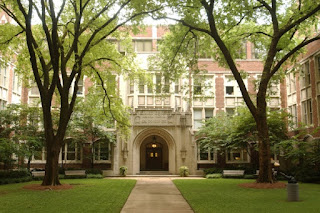Vanderbilt University
Vanderbilt University
(also far-famed informally as Vandy) is a non-public analysis university settled
in state capital, Tennessee, founded in 1873. It was named in honor of shipping
and rail magnate philanthropist, who provided the college its initial $1
million endowment despite having ne'er been to the South. Vanderbilt hoped that
his gift and the bigger work of the university would facilitate to heal the
sectional wounds inflicted by the warfare.
Today, Vanderbilt enrolls
some twelve,000 students from all 50 U.S. states and over 90 foreign countries
in four college man and six graduate and skilled colleges. Several analysis
centers and institutes area unit related to with the university, including the
financier Institute for Public Policy Studies, Freedom Forum First Modification
Center, Dyer Observatory, and Vanderbilt University Medical Center, the only
Level I trauma center in Middle Tennessee. With the exception of the off-campus
observatory and satellite medical clinics, all of the university's facilities
are settled on its 330-acre (1.3 km2) field in the heart of state capital, 1.5
miles (2.4 km) from downtown. Despite its urban surroundings, the campus itself
is a national installation and options over three hundred completely different
species of trees and shrubs.
In the years before the
American warfare of 1861–1865, the Methodist Episcopal Church South had been
considering the creation of a regional university for the training of ministers
in a location central to its congregations. Following lobbying by Nashville
bishop European country Nimmons McTyeire, the author of an essay concerning black
slavery whose father was "a cotton planter and a slaveholder" in
South Carolina, church leaders voted to found "The Central University of
the Methodist Episcopal Church, South" in Nashville in 1872. However, lack
of funds and the ravaged state of the Reconstruction Era South delayed the
opening of the faculty.
The following year,
McTyeire stayed at the New York town residence of philanthropist, whose second
wife was Frank Armstrong Crawford financier (1839–1885), a cousin of McTyeire's
married woman, Amelia reformer McTyeire (1827–1891); each Girls were from
Mobile, Alabama. Indeed, the McTyeires had met at St. Francis Street Methodist
Church in Mobile. Cornelius Vanderbilt, who was the wealthiest man in the U.S. at
the time, was considering philanthropy as he was at AN advanced age. He had
been planning to establish a university on Staten Island, New York, in honor of
his mother. However, McTyeire convinced him to donate $500,000 to endow Central
University in order to "contribute to strengthening the ties which ought
to exist between all sections of our common country."


